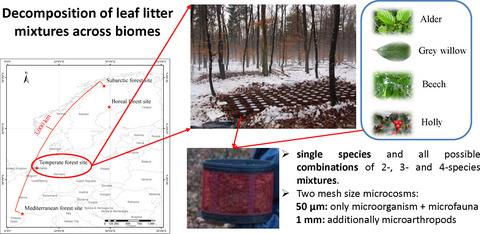Our official English website, www.x-mol.net, welcomes your
feedback! (Note: you will need to create a separate account there.)
Decomposition of leaf litter mixtures across biomes: The role of litter identity, diversity and soil fauna
Journal of Ecology ( IF 5.3 ) Pub Date : 2020-06-25 , DOI: 10.1111/1365-2745.13452 Shixing Zhou 1, 2 , Olaf Butenschoen 2, 3 , Sandra Barantal 4 , Ira Tanya Handa 4, 5 , Marika Makkonen 6 , Veronique Vos 7 , Rien Aerts 6 , Matty P. Berg 8, 9 , Brendan McKie 10, 11 , Jasper Van Ruijven 7 , Stephan Hättenschwiler 4 , Stefan Scheu 2, 12
中文翻译:

跨生物群落的凋落物混合物分解:凋落物特性,多样性和土壤动物群的作用
更新日期:2020-06-25
Journal of Ecology ( IF 5.3 ) Pub Date : 2020-06-25 , DOI: 10.1111/1365-2745.13452 Shixing Zhou 1, 2 , Olaf Butenschoen 2, 3 , Sandra Barantal 4 , Ira Tanya Handa 4, 5 , Marika Makkonen 6 , Veronique Vos 7 , Rien Aerts 6 , Matty P. Berg 8, 9 , Brendan McKie 10, 11 , Jasper Van Ruijven 7 , Stephan Hättenschwiler 4 , Stefan Scheu 2, 12
Affiliation

|
- At broad spatial scales, the factors regulating litter decomposition remain ambiguous, with the understanding of these factors largely based on studies investigating site‐specific single litter species, whereas studies using multi litter species mixtures across sites are rare.
- We exposed in microcosms containing single species and all possible mixtures of four leaf litter species differing widely in initial chemical and physical characteristics from a temperate forest to the climatic conditions of four different forests across the Northern Hemisphere for 1 year.
- Calcium, magnesium and condensed tannins predicted litter mass loss of single litter species and mixtures across forest types and biomes, regardless of species richness and microarthropod presence. However, relative mixture effects differed among forest types and varied with the access to the litter by microarthropods. Access to the microcosms by microarthropods modified the decomposition of individual litter species within mixtures, which differed among forest types independent of litter species richness and composition of litter mixtures. However, soil microarthropods generally only little affected litter decomposition.
- Synthesis. We conclude that litter identity is the dominant driver of decomposition across different forest types and the non‐additive litter mixture effects vary among biomes despite identical leaf litter chemistry. These results suggest that across large spatial scales the environmental context of decomposing litter mixtures, including microarthropod communities, determine the decomposition of litter mixtures besides strong litter trait‐based effects.
中文翻译:

跨生物群落的凋落物混合物分解:凋落物特性,多样性和土壤动物群的作用
- 在广泛的空间尺度上,调节凋落物分解的因素仍然是模棱两可的,对这些因素的理解主要是基于调查特定地点的单个凋落物物种的研究,而很少使用跨位置的多种凋落物物种混合物的研究。
- 我们暴露了包含单一物种和四种可能的混合物的微观世界的缩影,这些混合物的最初化学和物理特性从温带森林到北半球四种不同森林的气候条件差异很大,为期一年。
- 钙,镁和浓缩单宁可预测整个森林类型和生物群落中单一凋落物物种和混合物的凋落物质量损失,无论物种丰富度和微节肢动物的存在如何。但是,相对的混合效应在不同的森林类型中有所不同,并且随着微型节肢动物对垃圾的获取而变化。微型节肢动物进入微观世界改变了混合物中单个凋落物种类的分解,森林类型因凋落物种类丰富度和凋落物混合物的组成而异。但是,土壤微节肢动物通常只很少影响凋落物的分解。
- 综合。我们得出的结论是,尽管叶片凋落物化学性质相同,但不同森林类型中凋落物的身份是分解的主要驱动力,并且不同生物群落的非附加凋落物混合效应也不同。这些结果表明,在较大的空间尺度上,分解垃圾混合物(包括微节肢动物群落)的环境背景,除了基于垃圾的性状强烈影响外,还决定了垃圾混合物的分解。











































 京公网安备 11010802027423号
京公网安备 11010802027423号